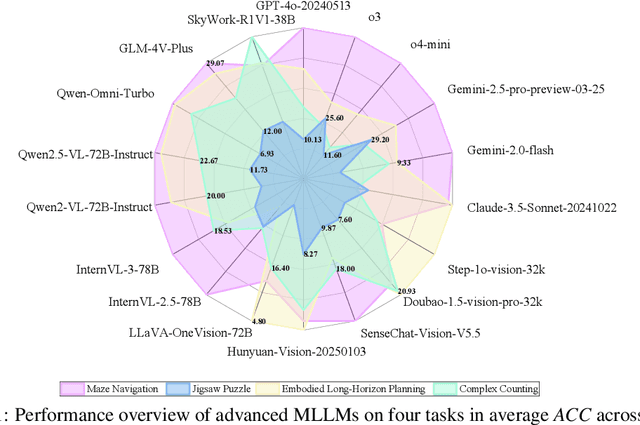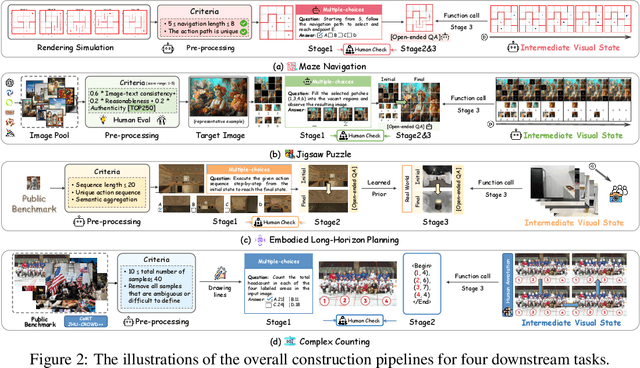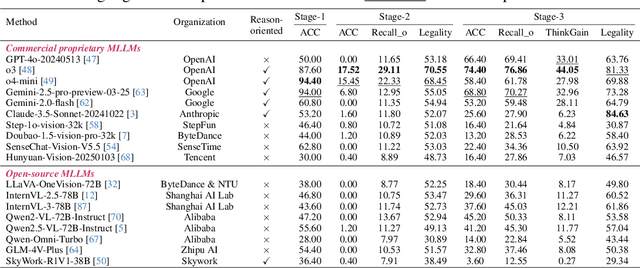Xuecheng Wu
MUSE: MCTS-Driven Red Teaming Framework for Enhanced Multi-Turn Dialogue Safety in Large Language Models
Sep 18, 2025Abstract:As large language models~(LLMs) become widely adopted, ensuring their alignment with human values is crucial to prevent jailbreaks where adversaries manipulate models to produce harmful content. While most defenses target single-turn attacks, real-world usage often involves multi-turn dialogues, exposing models to attacks that exploit conversational context to bypass safety measures. We introduce MUSE, a comprehensive framework tackling multi-turn jailbreaks from both attack and defense angles. For attacks, we propose MUSE-A, a method that uses frame semantics and heuristic tree search to explore diverse semantic trajectories. For defense, we present MUSE-D, a fine-grained safety alignment approach that intervenes early in dialogues to reduce vulnerabilities. Extensive experiments on various models show that MUSE effectively identifies and mitigates multi-turn vulnerabilities. Code is available at \href{https://github.com/yansiyu02/MUSE}{https://github.com/yansiyu02/MUSE}.
End4: End-to-end Denoising Diffusion for Diffusion-Based Inpainting Detection
Sep 16, 2025Abstract:The powerful generative capabilities of diffusion models have significantly advanced the field of image synthesis, enhancing both full image generation and inpainting-based image editing. Despite their remarkable advancements, diffusion models also raise concerns about potential misuse for malicious purposes. However, existing approaches struggle to identify images generated by diffusion-based inpainting models, even when similar inpainted images are included in their training data. To address this challenge, we propose a novel detection method based on End-to-end denoising diffusion (End4). Specifically, End4 designs a denoising reconstruction model to improve the alignment degree between the latent spaces of the reconstruction and detection processes, thus reconstructing features that are more conducive to detection. Meanwhile, it leverages a Scale-aware Pyramid-like Fusion Module (SPFM) that refines local image features under the guidance of attention pyramid layers at different scales, enhancing feature discriminability. Additionally, to evaluate detection performance on inpainted images, we establish a comprehensive benchmark comprising images generated from five distinct masked regions. Extensive experiments demonstrate that our End4 effectively generalizes to unseen masking patterns and remains robust under various perturbations. Our code and dataset will be released soon.
TiKMiX: Take Data Influence into Dynamic Mixture for Language Model Pre-training
Aug 25, 2025Abstract:The data mixture used in the pre-training of a language model is a cornerstone of its final performance. However, a static mixing strategy is suboptimal, as the model's learning preferences for various data domains shift dynamically throughout training. Crucially, observing these evolving preferences in a computationally efficient manner remains a significant challenge. To address this, we propose TiKMiX, a method that dynamically adjusts the data mixture according to the model's evolving preferences. TiKMiX introduces Group Influence, an efficient metric for evaluating the impact of data domains on the model. This metric enables the formulation of the data mixing problem as a search for an optimal, influence-maximizing distribution. We solve this via two approaches: TiKMiX-D for direct optimization, and TiKMiX-M, which uses a regression model to predict a superior mixture. We trained models with different numbers of parameters, on up to 1 trillion tokens. TiKMiX-D exceeds the performance of state-of-the-art methods like REGMIX while using just 20% of the computational resources. TiKMiX-M leads to an average performance gain of 2% across 9 downstream benchmarks. Our experiments reveal that a model's data preferences evolve with training progress and scale, and we demonstrate that dynamically adjusting the data mixture based on Group Influence, a direct measure of these preferences, significantly improves performance by mitigating the underdigestion of data seen with static ratios.
AD-AVSR: Asymmetric Dual-stream Enhancement for Robust Audio-Visual Speech Recognition
Aug 11, 2025Abstract:Audio-visual speech recognition (AVSR) combines audio-visual modalities to improve speech recognition, especially in noisy environments. However, most existing methods deploy the unidirectional enhancement or symmetric fusion manner, which limits their capability to capture heterogeneous and complementary correlations of audio-visual data-especially under asymmetric information conditions. To tackle these gaps, we introduce a new AVSR framework termed AD-AVSR based on bidirectional modality enhancement. Specifically, we first introduce the audio dual-stream encoding strategy to enrich audio representations from multiple perspectives and intentionally establish asymmetry to support subsequent cross-modal interactions. The enhancement process involves two key components, Audio-aware Visual Refinement Module for enhanced visual representations under audio guidance, and Cross-modal Noise Suppression Masking Module which refines audio representations using visual cues, collaboratively leading to the closed-loop and bidirectional information flow. To further enhance correlation robustness, we adopt a threshold-based selection mechanism to filter out irrelevant or weakly correlated audio-visual pairs. Extensive experimental results on the LRS2 and LRS3 datasets indicate that our AD-AVSR consistently surpasses SOTA methods in both performance and noise robustness, highlighting the effectiveness of our model design.
A Trustworthy Method for Multimodal Emotion Recognition
Aug 11, 2025Abstract:Existing emotion recognition methods mainly focus on enhancing performance by employing complex deep models, typically resulting in significantly higher model complexity. Although effective, it is also crucial to ensure the reliability of the final decision, especially for noisy, corrupted and out-of-distribution data. To this end, we propose a novel emotion recognition method called trusted emotion recognition (TER), which utilizes uncertainty estimation to calculate the confidence value of predictions. TER combines the results from multiple modalities based on their confidence values to output the trusted predictions. We also provide a new evaluation criterion to assess the reliability of predictions. Specifically, we incorporate trusted precision and trusted recall to determine the trusted threshold and formulate the trusted Acc. and trusted F1 score to evaluate the model's trusted performance. The proposed framework combines the confidence module that accordingly endows the model with reliability and robustness against possible noise or corruption. The extensive experimental results validate the effectiveness of our proposed model. The TER achieves state-of-the-art performance on the Music-video, achieving 82.40% Acc. In terms of trusted performance, TER outperforms other methods on the IEMOCAP and Music-video, achieving trusted F1 scores of 0.7511 and 0.9035, respectively.
eMotions: A Large-Scale Dataset and Audio-Visual Fusion Network for Emotion Analysis in Short-form Videos
Aug 09, 2025Abstract:Short-form videos (SVs) have become a vital part of our online routine for acquiring and sharing information. Their multimodal complexity poses new challenges for video analysis, highlighting the need for video emotion analysis (VEA) within the community. Given the limited availability of SVs emotion data, we introduce eMotions, a large-scale dataset consisting of 27,996 videos with full-scale annotations. To ensure quality and reduce subjective bias, we emphasize better personnel allocation and propose a multi-stage annotation procedure. Additionally, we provide the category-balanced and test-oriented variants through targeted sampling to meet diverse needs. While there have been significant studies on videos with clear emotional cues (e.g., facial expressions), analyzing emotions in SVs remains a challenging task. The challenge arises from the broader content diversity, which introduces more distinct semantic gaps and complicates the representations learning of emotion-related features. Furthermore, the prevalence of audio-visual co-expressions in SVs leads to the local biases and collective information gaps caused by the inconsistencies in emotional expressions. To tackle this, we propose AV-CANet, an end-to-end audio-visual fusion network that leverages video transformer to capture semantically relevant representations. We further introduce the Local-Global Fusion Module designed to progressively capture the correlations of audio-visual features. Besides, EP-CE Loss is constructed to globally steer optimizations with tripolar penalties. Extensive experiments across three eMotions-related datasets and four public VEA datasets demonstrate the effectiveness of our proposed AV-CANet, while providing broad insights for future research. Moreover, we conduct ablation studies to examine the critical components of our method. Dataset and code will be made available at Github.
HOLA: Enhancing Audio-visual Deepfake Detection via Hierarchical Contextual Aggregations and Efficient Pre-training
Jul 30, 2025Abstract:Advances in Generative AI have made video-level deepfake detection increasingly challenging, exposing the limitations of current detection techniques. In this paper, we present HOLA, our solution to the Video-Level Deepfake Detection track of 2025 1M-Deepfakes Detection Challenge. Inspired by the success of large-scale pre-training in the general domain, we first scale audio-visual self-supervised pre-training in the multimodal video-level deepfake detection, which leverages our self-built dataset of 1.81M samples, thereby leading to a unified two-stage framework. To be specific, HOLA features an iterative-aware cross-modal learning module for selective audio-visual interactions, hierarchical contextual modeling with gated aggregations under the local-global perspective, and a pyramid-like refiner for scale-aware cross-grained semantic enhancements. Moreover, we propose the pseudo supervised singal injection strategy to further boost model performance. Extensive experiments across expert models and MLLMs impressivly demonstrate the effectiveness of our proposed HOLA. We also conduct a series of ablation studies to explore the crucial design factors of our introduced components. Remarkably, our HOLA ranks 1st, outperforming the second by 0.0476 AUC on the TestA set.
HKD4VLM: A Progressive Hybrid Knowledge Distillation Framework for Robust Multimodal Hallucination and Factuality Detection in VLMs
Jun 16, 2025Abstract:Driven by the rapid progress in vision-language models (VLMs), the responsible behavior of large-scale multimodal models has become a prominent research area, particularly focusing on hallucination detection and factuality checking. In this paper, we present the solution for the two tracks of Responsible AI challenge. Inspirations from the general domain demonstrate that a smaller distilled VLM can often outperform a larger VLM that is directly tuned on downstream tasks, while achieving higher efficiency. We thus jointly tackle two tasks from the perspective of knowledge distillation and propose a progressive hybrid knowledge distillation framework termed HKD4VLM. Specifically, the overall framework can be decomposed into Pyramid-like Progressive Online Distillation and Ternary-Coupled Refinement Distillation, hierarchically moving from coarse-grained knowledge alignment to fine-grained refinement. Besides, we further introduce the mapping shift-enhanced inference and diverse augmentation strategies to enhance model performance and robustness. Extensive experimental results demonstrate the effectiveness of our HKD4VLM. Ablation studies provide insights into the critical design choices driving performance gains.
NTIRE 2025 challenge on Text to Image Generation Model Quality Assessment
May 22, 2025Abstract:This paper reports on the NTIRE 2025 challenge on Text to Image (T2I) generation model quality assessment, which will be held in conjunction with the New Trends in Image Restoration and Enhancement Workshop (NTIRE) at CVPR 2025. The aim of this challenge is to address the fine-grained quality assessment of text-to-image generation models. This challenge evaluates text-to-image models from two aspects: image-text alignment and image structural distortion detection, and is divided into the alignment track and the structural track. The alignment track uses the EvalMuse-40K, which contains around 40K AI-Generated Images (AIGIs) generated by 20 popular generative models. The alignment track has a total of 371 registered participants. A total of 1,883 submissions are received in the development phase, and 507 submissions are received in the test phase. Finally, 12 participating teams submitted their models and fact sheets. The structure track uses the EvalMuse-Structure, which contains 10,000 AI-Generated Images (AIGIs) with corresponding structural distortion mask. A total of 211 participants have registered in the structure track. A total of 1155 submissions are received in the development phase, and 487 submissions are received in the test phase. Finally, 8 participating teams submitted their models and fact sheets. Almost all methods have achieved better results than baseline methods, and the winning methods in both tracks have demonstrated superior prediction performance on T2I model quality assessment.
ViC-Bench: Benchmarking Visual-Interleaved Chain-of-Thought Capability in MLLMs with Free-Style Intermediate State Representations
May 20, 2025



Abstract:Visual-Interleaved Chain-of-Thought (VI-CoT) enables MLLMs to continually update their understanding and decisions based on step-wise intermediate visual states (IVS), much like a human would, which demonstrates impressive success in various tasks, thereby leading to emerged advancements in related benchmarks. Despite promising progress, current benchmarks provide models with relatively fixed IVS, rather than free-style IVS, whch might forcibly distort the original thinking trajectories, failing to evaluate their intrinsic reasoning capabilities. More importantly, existing benchmarks neglect to systematically explore the impact factors that IVS would impart to untamed reasoning performance. To tackle above gaps, we introduce a specialized benchmark termed ViC-Bench, consisting of four representive tasks: maze navigation, jigsaw puzzle, embodied long-horizon planning, and complex counting, where each task has dedicated free-style IVS generation pipeline supporting function calls. To systematically examine VI-CoT capability, we propose a thorough evaluation suite incorporating a progressive three-stage strategy with targeted new metrics. Besides, we establish Incremental Prompting Information Injection (IPII) strategy to ablatively explore the prompting factors for VI-CoT. We extensively conduct evaluations for 18 advanced MLLMs, revealing key insights into their VI-CoT capability. Our proposed benchmark is publicly open at Huggingface.
 Add to Chrome
Add to Chrome Add to Firefox
Add to Firefox Add to Edge
Add to Edge